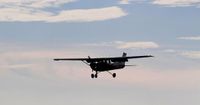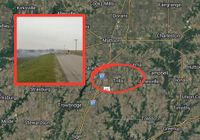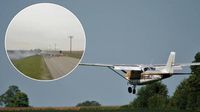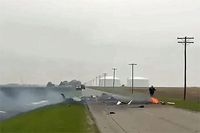On Saturday, April 19, 2025, a tragic plane crash occurred in central Illinois, USA, resulting in the deaths of all four individuals aboard a Cessna C180G single-engine aircraft. The accident took place shortly after 10 AM local time, near the small town of Trilla, as reported by the National Transportation Safety Board (NTSB).
The victims, identified as two women and two men, have not yet been publicly named pending notification of their families, according to Coles County coroner Ed Schniers. The NTSB is currently investigating the causes of the crash, with preliminary findings indicating that the plane may have struck power lines before the incident.
"Terrible news from Coles County," Illinois Governor JB Pritzker expressed on social media platform X. He added that his administration is closely monitoring the situation and keeping the victims' families in their thoughts.
This incident marks a somber moment in aviation safety, as it follows another plane crash that occurred just days earlier on Good Friday in Nebraska. In that incident, a small plane fell into the Platte River around 8:15 PM, and the bodies of all victims were subsequently recovered.
As the investigation into the Illinois crash unfolds, the NTSB has stated that a full report detailing the findings will be published within 30 days. An expert is scheduled to examine the wreckage and crash site on Sunday, April 20, 2025, to gather further insights into the circumstances surrounding this devastating event.
In the wake of these tragedies, questions arise about aviation safety protocols and measures in place to prevent such accidents. The NTSB, which is tasked with investigating transportation accidents, emphasizes the importance of thorough investigations to understand the causes and improve safety standards.
The community in Coles County is grappling with the shock of the incident, as residents come to terms with the loss of life. Local officials have expressed their condolences and support for the families affected by the crash, highlighting the tight-knit nature of the community.
In the broader context of aviation, incidents like these remind us of the inherent risks involved in air travel. While flying is statistically one of the safest modes of transportation, accidents can occur, often with tragic consequences. The investigation will seek to identify any factors that may have contributed to the crash, including potential mechanical failures or human error.
As the NTSB continues its work, the focus remains on honoring the memory of those who lost their lives in this incident. The agency's findings will not only provide answers for the families but also contribute to the ongoing efforts to enhance aviation safety.
In summary, the crash of the Cessna C180G in central Illinois serves as a stark reminder of the fragility of life and the unpredictability of aviation. As the investigation progresses, the hope is that lessons learned will help prevent similar tragedies in the future.
Meanwhile, the Nebraska crash is also under investigation, with authorities working to determine the causes and circumstances surrounding that incident. The NTSB has reiterated that it does not speculate on the causes of accidents during the investigation phase, ensuring that all findings are based on thorough analysis.
As these two incidents unfold, they highlight the importance of vigilance in aviation safety and the need for continuous improvement in protocols to protect passengers and crew alike. The aviation industry must learn from these tragedies to prevent future loss of life.
In the face of such sorrow, communities often come together to support one another. Vigils and memorials are expected to be held in honor of the victims, providing a space for grieving families and friends to remember their loved ones.
As we await the NTSB's report and further details from the investigations, the stories of those who lost their lives will remain at the forefront of discussions surrounding aviation safety. The hope is that through understanding the circumstances of these crashes, we can work towards a safer future for all who take to the skies.








